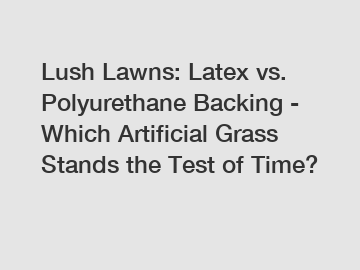Lush Lawns: Latex vs. Polyurethane Backing - Which Artificial Grass Stands the Test of Time?
Lush Lawns: Latex vs. Polyurethane Backing - Which Artificial Grass Stands the Test of Time?
Maintaining a lush and vibrant lawn has become easier with the advent of artificial grass. However, when it comes to choosing the right backing material for your artificial turf, the decision becomes crucial. Latex and polyurethane are two common options, each with its own set of advantages and disadvantages. In this article, we will explore the qualities of both latex and polyurethane backing, analyze their durability, and discuss the significance and impact of this choice on the longevity of your artificial lawn.
Latex backing has long been the standard in the artificial grass industry. It is made from a natural rubber compound and provides a flexible and resilient foundation for the synthetic blades. Latex backing offers good drainage, allowing water to flow through efficiently. It also helps to prevent shifting and movement of the turf. These qualities have made latex an attractive option for many homeowners and sports facilities.

On the other hand, polyurethane backing has gained popularity in recent years due to its enhanced durability. Polyurethane is a synthetic material that offers superior strength and resistance against wear and tear. Its robust nature allows for heavy foot traffic without compromising the integrity of the turf. Additionally, polyurethane backing provides excellent dimensional stability, ensuring that the artificial grass maintains its original shape and appearance over time.
To determine which backing material truly stands the test of time, several factors must be considered. Firstly, the climate and weather conditions play a significant role. Latex backing can be prone to deterioration and cracking under extreme heat or freezing temperatures. Polyurethane, on the other hand, is more resilient and less affected by weather variations.
Secondly, the level of usage and foot traffic should be taken into account. In high-traffic areas such as sports fields or playgrounds, polyurethane backing offers superior resistance to heavy use. Its durability ensures that the turf remains intact and functional, even after prolonged and intensive activity. For residential lawns with lighter use, latex backing may suffice, although polyurethane can still provide added longevity.
Furthermore, the installation process can affect the performance of the backing material. Proper installation techniques, including adequate compaction and secure seaming, are essential for both latex and polyurethane backing. However, polyurethane's dimensional stability can help maintain its shape and prevent issues such as ripples or wrinkles in the turf.
The choice between latex and polyurethane backing is crucial as it directly impacts the longevity of your artificial grass. Opting for a durable backing material ensures that your lawn remains beautiful and functional for years to come. Moreover, it reduces the need for frequent replacements, saving you both time and money in the long run.
In conclusion, both latex and polyurethane backing have their merits, but when it comes to standing the test of time, polyurethane emerges as the superior choice. Its enhanced durability, resistance to wear and tear, and superior dimensional stability make it ideal for areas with heavy foot traffic. However, it is essential to consider individual factors such as climate, usage, and installation techniques to make an informed decision. By selecting the right backing material, you can enjoy a lush and vibrant artificial lawn that will withstand the test of time.
If you want to learn more, please visit our website acrylic emulsions, styrene butadiene latex emulsion, Artificial Turf Backings Compared; Latex or Polyurethane, which is better?.
231
0
0

Comments
All Comments (0)